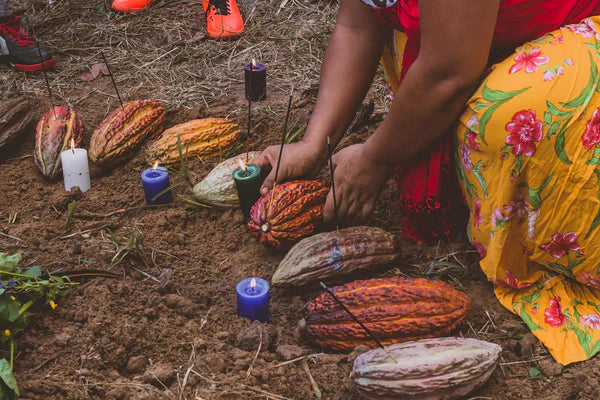
From sacred cocoa to industrial chocolate bars: Back to the origins
shares
Cocoa has a history spanning several millennia—from a sacred food of indigenous peoples to a sweet, mass-produced commodity on supermarket shelves. In countries of origin like Mexico and Colombia, cocoa was originally processed and consumed in a way that preserved its natural flavors and health benefits—long before industry intervened with sugar, milk powder, and chemicals.
This article is a wake-up call for consumers and a source of inspiration for chefs: We explore the original cultivation, ritual significance, traditional recipes, and health benefits—and show why real, non-alkali-treated cacao is the better, healthier, and fairer choice today.
Cocoa in Mexico: Origin and Ritual
In Mexico, cacao has always been considered the "food of the gods." The Maya and Aztecs used it as a medicine, a means of payment, and especially in ceremonies. Their cacao was a strong, bitter drink , often flavored with chili, vanilla, or corn flour and whipped into a sacred foam.
Even today, it's common in Mexico to drink cacao rather than eat it . The beans are harvested by hand, fermented, dried in the sun, lightly roasted, and then ground into a coarse paste on a metate (stone slab). This creates tabletas de chocolate , which are dissolved with hot water or milk and spices like cinnamon or chili. The cacao is whipped into a foam with a molinillo , a wooden whisk—just as it was done hundreds of years ago.
The result: a rustic, nutritious drink with a bittersweet flavor that's a far cry from sugary cocoa mixes from the supermarket.
Cocoa in Colombia: From the field to the cup
In Colombia, too, cocoa is an integral part of the culinary culture. Small farmers harvest the cocoa pods by hand, ferment the beans in wooden boxes or under banana leaves, dry them in the sun, and gently roast them. This creates natural cocoa with a full aroma.
Colombia's Chocolate Santafereño is particularly well-known: a small bar of cocoa (with a little panela , unrefined cane sugar, and spices) is dissolved in milk and whipped with a bolinillo until frothy. The highlight: pieces of mild cheese are added to the hot drink, slowly melting to create sweet and salty bites in the cocoa. A comforting, satisfying ritual that many Colombians still enjoy daily.
Tradition vs. Industry: What has changed?
The difference between traditional cocoa and industrial chocolate is enormous:
- Simplicity: In Mexico and Colombia, you usually only need cocoa, some unrefined sugar, and spices.
- Industrial products: Today's chocolate often contains more sugar than cocoa (50–60%), as well as emulsifiers, flavorings, milk powder, and fat substitutes.
Another breakthrough was alkalization (the Dutch process) . To reduce bitterness and change the color, cocoa is treated with alkali. The problem: This process results in the loss of over half of the valuable polyphenols – the antioxidants that actually make cocoa so healthy.
It's important to note, however, that the intensity of the bitterness depends heavily on the cocoa variety. In West Africa, especially in the Ivory Coast, for decades, the focus has been on varieties that produce high yields but are often bland in flavor and contain a lot of bitterness. These beans had to be "market-ready" for the global market—this is where alkalization comes in. It often serves less to refine flavor than to conceal inferior quality , transforming mass-produced cocoa into a product acceptable to consumers.
High-quality varieties from Mexico, Colombia, or even Venezuela, on the other hand , naturally possess a balanced flavor profile that is tasty and complex without chemical treatment. Good cocoa doesn't need to be alkalized —it's simply delicious.
Over-roasting at high temperatures also further reduces flavanol content and alters fiber. While this creates a consistent flavor, complexity and health benefits disappear .
Health benefits of real cocoa
Unprocessed cocoa is a real nutritional bomb :
Heart & Circulation: Flavanols lower blood pressure, improve blood circulation and protect against heart disease.
Mood & Energy: Theobromine has a gentle stimulating effect, along with serotonin precursors and the so-called “bliss molecule” anandamide.
Minerals & Fiber: Cocoa provides magnesium, iron, zinc, copper and potassium as well as valuable fiber for digestion.
The key point: These benefits are only available in natural, non-alkalinized cocoa – not in sugar bombs from the supermarket.
Traditional recipes to try
Mexican hot chocolate: Whisk 2 tablespoons of natural cocoa powder with hot water, a pinch of cinnamon, chili, and a touch of honey or piloncillo . Beat with a molinillo until frothy.
Colombian Chocolate Santafereño: Dissolve a small cocoa bar in hot milk, season with cinnamon, and melt a few pieces of mild cheese in the cup.
Both drinks demonstrate that real cocoa is an experience – intense, nutritious, and at the same time a piece of cultural history.
Conclusion: Back to the roots of cocoa
Traditional cacao from Mexico and Colombia is more than just a beverage —it's a ritual, medicine, and pleasure all rolled into one. While industrial chocolate is criticized as an "ultra-processed food," the original cacao offers a path to health, taste, and fairness .
Those who choose real, unprocessed cocoa support small farmers, preserve ancient traditions and enjoy chocolate as it was intended: pure, bitter and divine .
